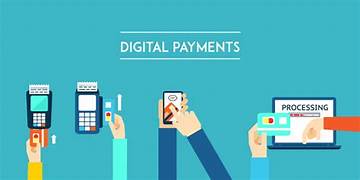Exploring the Role of Digital Payment Systems in Modern Finance
In the modern financial landscape, digital payment systems have become indispensable. As technological advancements reshape how individuals, businesses, and governments conduct transactions, the shift from traditional payment methods to digital systems is not only evident but transformative. From mobile wallets to blockchain-based platforms, digital payment systems are driving financial inclusion, enhancing transaction efficiency, and revolutionizing global commerce. This article delves into the role of digital payment systems in modern finance, exploring their benefits, challenges, and future potential.
Understanding Digital Payment Systems
Digital payment systems refer to electronic methods of transferring money or value without the need for physical cash. These systems encompass a wide array of technologies, including:
- Mobile Payment Platforms:
Services like Apple Pay, Google Pay, and Samsung Pay enable users to make purchases through smartphones using Near Field Communication (NFC) technology. - E-Wallets:
Platforms like PayPal, Venmo, and Alipay store users’ payment details securely, allowing them to make online or in-store transactions effortlessly. - Cryptocurrencies:
Blockchain-based digital currencies like Bitcoin and Ethereum facilitate decentralized and secure payments across borders. - Online Banking and Payment Gateways:
Traditional banks have adapted by offering online payment services, while gateways like Stripe and Square streamline e-commerce transactions. - Peer-to-Peer (P2P) Payment Systems:
Platforms like Zelle and Cash App simplify money transfers between individuals.
The Impact of Digital Payment Systems
- Enhancing Financial Inclusion:
Digital payment systems have bridged gaps for the unbanked and underbanked populations. In developing countries, mobile money services like M-Pesa in Kenya have enabled millions to access financial services without the need for a formal bank account. - Boosting Efficiency and Convenience:
Digital payments reduce the friction associated with cash transactions. They enable instant payments, eliminate the need for physical currency, and offer users the convenience of making transactions anytime and anywhere. - Facilitating Global Commerce:
Cross-border payments have been revolutionized by digital systems. Cryptocurrencies and platforms like PayPal simplify international transactions, reducing costs and increasing speed compared to traditional banking systems. - Promoting Transparency and Security:
Digital payments offer traceability, making it easier to track transactions and combat fraud. Blockchain technology, in particular, ensures data integrity and reduces risks associated with data breaches. - Driving Economic Growth:
The widespread adoption of digital payment systems boosts economic activity by streamlining trade, reducing transaction costs, and increasing consumer spending.
Challenges of Digital Payment Systems
While digital payment systems offer numerous advantages, they also face significant challenges:
- Cybersecurity Risks:
With the rise of digital transactions, cyberattacks, data breaches, and identity theft have become major concerns. Ensuring robust security measures is paramount to protect users’ sensitive information. - Digital Divide:
Not everyone has equal access to digital payment systems due to disparities in internet connectivity, technological infrastructure, and digital literacy, particularly in rural and underserved areas. - Regulatory Hurdles:
The global nature of digital payments requires navigating diverse regulatory landscapes. Ensuring compliance with anti-money laundering (AML) and know-your-customer (KYC) requirements can be complex. - High Transaction Costs:
Despite being more efficient, some digital payment systems impose fees that can be prohibitive for small businesses and low-income users. - Technical Issues:
System downtimes, glitches, and compatibility issues can disrupt transactions and erode user trust.
Success Stories in Digital Payments
- M-Pesa:
Launched in Kenya, M-Pesa has transformed financial services for millions, enabling users to send and receive money, pay bills, and access microloans via mobile phones. - Alipay and WeChat Pay:
In China, these platforms dominate the digital payment landscape, facilitating everything from retail purchases to peer-to-peer transfers and integrating seamlessly with other services like ride-hailing and food delivery. - Square:
By offering affordable and user-friendly point-of-sale systems, Square has empowered small businesses to accept digital payments, expanding their reach and efficiency. - Cryptocurrency Adoption:
Companies like Tesla and Overstock have embraced cryptocurrency payments, showcasing the growing acceptance of blockchain-based systems in mainstream commerce.
Best Practices for Implementing Digital Payment Systems
- Prioritize Security:
Employ robust encryption, multi-factor authentication, and real-time monitoring to protect user data and transactions. - Ensure User-Friendly Interfaces:
Simplify the user experience with intuitive designs and clear instructions, reducing barriers to adoption. - Promote Digital Literacy:
Educate users about the benefits and functionalities of digital payment systems, particularly in underserved communities. - Collaborate with Regulators:
Work closely with governments and financial authorities to ensure compliance and foster trust. - Adopt Scalable Technologies:
Use flexible and scalable systems to accommodate growing transaction volumes and evolving user needs.
The Future of Digital Payment Systems
- Integration with Emerging Technologies:
The convergence of digital payments with artificial intelligence (AI), the Internet of Things (IoT), and biometrics will enhance personalization, security, and efficiency. - Expansion of Central Bank Digital Currencies (CBDCs):
Several governments are exploring CBDCs as a secure and efficient alternative to traditional fiat currencies, with potential implications for monetary policy and financial inclusion. - Increased Adoption of Blockchain:
Blockchain technology will continue to drive innovation in digital payments by improving transparency, reducing costs, and enabling smart contracts. - Focus on Sustainability:
As environmental concerns grow, digital payment systems will adopt greener practices, such as reducing energy consumption in blockchain networks. - Global Standardization:
Efforts to harmonize regulations and standards across borders will simplify international transactions and encourage broader adoption of digital payment systems.
Conclusion
Digital payment systems have redefined the way money moves in the modern economy. By enhancing accessibility, efficiency, and security, these systems empower individuals and businesses while driving global economic growth. Despite challenges such as cybersecurity risks and regulatory complexities, the continued evolution of digital payment technologies promises a future where financial transactions are more seamless, inclusive, and innovative than ever before. Embracing these advancements is not merely an option but a necessity for staying competitive in an increasingly digital world.


